-
Posts
1,760 -
Joined
-
Last visited
Content Type
Profiles
Forums
Store
Help Articles
Posts posted by Wholemeal Crank
-
-
Brilliant repurposing of the strap wrench. I bought one of those for a single kitchen faucet repair (still cheaper than calling the plumber), but have not used it since. It's going to come back to the ktichen to stay now.
-
Nothing is better for cracking nuts than a Vise-grip. I have been working on a small bag of whole macadamia nuts brought back from Hawaii, and the Vise-grip gives a nice, controllable crack, far superior to the otherwise inevitable hammer. I've even contemplated getting a nice stainless-steel version from a medical supply house to keep in the kitchen for this and other tasks that get it wet and risk rusting.
-
I've been drinking the usual nearly random selections of green teas, oolongs, puerhs, but no black teas recently. Yesterday I had the pleasure of introducing puerh to a tea-drinker who mostly drank green tea from tea bags. I'd stopped by her desk at the office with the occasional oolong, first some light greens, then some deeper traditional roast TGY and Da Hong Pao, but yesterday I prepared some Menghai Silver Dayi sheng puerh (from Norbu) and she made a point of telling me later how much she had enjoyed it, before I had a chance to ask her about it. Heh.
Had some wood-roasted Shui Xian from HouDe last night, and this morning enjoying some Den's Shin-ryoku sencha to start the day properly, with jam and toast.
-
I have so many parents bring kids to my clinic and tell them that if they won't behave for me, they won't get their McDonald's afterwards. And the kids aren't just after the Happy Meals.
Blech!
-
I can second the recommendation for the Story of Tea.
When I tried the Sunpu Boucha, I brewed it very cool--about 150 degrees--and started very short infusions--30 seconds, then 15, 30, 45, 45 seconds. In those infusions, I had no bitterness.
-
As it happens, I'm drinking it again for the first time right now. It's coming out light and sweet and delightful. I didn't weigh it before preparing the tea, but I'm pretty sure I brewed it a lot lighter--you'd find my sweet water amusing. But it is delightful right now, sweet and mellow, not at all nutty like a Dragon Well. It's actually a lot closer to the very delicate and fantastic 'white' tea of An Ji (actually a green tea). I'm brewing it very cool--150 degrees. Mmmm.
I think the key for me will be to keep it VERY dilute.
-
I discovered this thread and have been following with some interest. I really haven't had much opportunity to try modernist dishes with new foams (but have MC, will be trying some), but in theory I love the idea of using a foam to bring some strong flavor to a dish without turning them into a traditional sauce that dilutes the flavors with thickening agents and may add a lot of fat calories. I would not be excited if the foam looked like spit on my plate, but as long as it didn't bring up strong associations of bodily effluvia, I'd love to try more of it.
-
I learned to love Swedish fish when I was working in an ice cream and candy shop, and had just become allergic to chocolate. They were my favorite of the permissible chocolate-free candies. One fish could be savored in small nibbles, and the different colors had distinct and pleasing flavors. Yes, they're not flavored much like actual fruit, but they were and remain a tasty treat. Sadly, though, with the popularity of the small boxes or bags of just mini red fish, it's gotten a little harder to find the full color spectrum without buying a very large bag--and because they are just flavored sugar and starch, I really don't like bringing home such a big bag.
Here's hoping that the other sea creatures will be more available in different colors than the fish...
-
Today, not a lot of tea. Drank some cold-brewed sencha (an inexpensive sencha I tossed in cold water, purchased from my chinatown tea shop), and then some Yin Zhen Silver Needle from jingteashop. Reminds me of how much I like silver needle. So enjoying the plain teas that I have very little interest in flavored teas--gave away an overly strong milk oolong recently, because there are so many unflavored fantastic oolongs out there.
-
One of the reasons for using long, retarded fermentation is to boost amylase activity, and one of the consequences is a darker, reddish-brown crust.
However, if you give it three days (retarded) fermentation, AND use whole-grain 'damaged' high amylase (sprouted) wheat grain, then a gummy crust looks like a very likely consequence.
That may be the key point--combining flour that is 'green', from sprouted wheat, AND the long fermentation may be the perfect storm here. I have the same problem, generally to a lesser degree, with my usual bread made from fresh milled flour with long retardation.
It's time to do some experiments--I won't be doing the sprouted wheat again for a while, as it was very time and energy intensive, but perhaps one dough prepped from fresh milled flour and retarded a few hours, 24 hours, 48 hours, etc, to see if gumminess develops differently in them.
-
Depends on the tea, not the teabag: I've gotten several resteepings from a nice oolong tea that happened to be bagged, and some really nice sencha, but wouldn't push a cheap black tea....wouldn't steep a cheap black tea even once, actually.
-
Excellent! Do you know what kind of teas you'll be tasting, so you can read up on the relevant chapters?
-
Happy camper with my Nordic Ware poppers--have one for home and one for the office. Inexpensive, highly functional, and portion enforcing: when using an air popper, it's easier to double up on the popcorn (and thus the amount of highly calorific toppings). With this one, if I season it in the bowl after popping (with real butter, or with butter plus popcorn sauce), I have to clean the bowl before I make more. So I eat it more sensibly than voraciously.
So far, I ignore the discoloration, use with any popcorn, and keep a measuring scoop in the jar of popcorn so I know one scoop per batch, and set the timing based on the sound of the kernels, just like with the commercially bagged product (for one slightly heaping 1/3 cup measure of generic yellow popcorn, 3:15 for my home microwave, and 2:20 for the more powerful machine at work). Set aside hot popcorn, melt butter, toss, and eat.
-
This weekend I've been 'breaking in' the mini yixing pot I wrote about in the teaware topic with a very fine aged puerh, 60s Guang Yun Gong from Essence of Tea. Although the little pot only holds about one ounce, really less since it's so stuffed with tea that the leaf takes up a significant portion of the tea, and some water is getting poured over the pot at times, the need to refill the kettle tells me that I've cycled at least a liter of water through this stuff, and it's still tasty. Wow. There's a particularly nice silky mouthfeel coming out in these later infusions.
Also have been enjoying Den's Shin-ryoku sencha, and between this and another packet of some of Norbu's Zairai sencha, I have some time to contemplate where to place my next sencha order. I really enjoyed my Yuuki-cha teas last year, but I'm quite tempted to explore a little further with other suppliers along with restocking that brilliant Sayamakaori. Another minor sencha breakthrough was realizing recently that I can often get another nice infusion out of my morning sencha by filling the kyusu with cold water and refrigerating it to drink later. I suspect I'll be trying a lot more cool-brewed teas when the hot weather comes to stay.
-
Huang Shen Mao Feng from Jing Tea Shop
I was very curious about this tea in particular because I've very much enjoyed Norbu's large-leaf green tea from Yunnan also called "Mao Feng", but I suspected it was quite different from the 'real thing', and wanted to see what the original was like.
Medium green, thin twisty leaves
on Flickr
5 grams in a 200mL pot with about 150mL of water, 150 degrees
First infusion 30 seconds, warm, sweet, a certain smoky/toasted/grilled vegetable background…..
2nd infusion 20 seconds, pale green liquor, the sweet warm flavor is still there, but the toasted vegetable flavor--not a bitterness, perhaps a touch of astringency in it--is dominant now.
Ran out of time, so I added cold water and set the leaves to the refrigerator to try to get one more steeping out of them. But the resulting infusion, a day later, has a strong bitterness underlying a delicious fresh sweet vegetal flavor; I did not finish it. I also forgot to shoot the leaves after infusion, but they were pale minty green, long, thin, rolled almost into little cylinders.
I used a quite moderate tea-to-water ratio, and very cool water with short brewing times, all designed to moderate and minimize any bitterness. This is a tea that sat, sealed from the shop, for some months before I opened it, so it might have lost something re: freshness. Before assuming this just isn't my cup of green tea, I'll try it again--it took me nearly a year to 'get' Dragon Well, after all.
-
Some recent teaware acquisitions starting with the tiniest yixing ever....
The newest, tiniest member of the household....first, trying to give a sense of scale--how tiny it is:
It matched sizes beautifully with the tiny green cup from a scent cup set.
Tiny teapot by debunix, on Flickr
I admit I bought it mostly as a novelty, but while it is so tiny that it's a bit awkward, the tea brewed in it (an aged puerh sample from Essence of Tea) was delicious. It's from Dragon Tea House on Ebay. While I was there, I also bought a very small gaiwan:
This is about the same size as some that I got as part of 'travel' sets, but more practical for routine use because it has a saucer that fits it snugly and helps me avoid burnt fingers.
-
My stock cupboard is nearly bare, and it's time to can more vegetable stock. The discussion about stocks in the Modernist Cuisine Q&A was something I was really looking forward to, and I'm definitely going to be trying some new things with this batch, but I also still have a lot of questions.
(1) Is there any reason, apart from the appearance of the final dish, why clarity matters for a vegetable stock, or, for that matter, any stock?
Does it signify some muddying of flavors to have some little bits of stuff flaking off the stock ingredients? If so, the traditional clarification steps at the end with eggs or gelatin or skimming make sense. If the issue to that cloudy bits mean the stuff was poorly handled in ways that degrade the flavor--e.g., potatoes or celery cooked to the point of dissolving are also releasing some unpleasant element into the stock--then clarifying at the end makes no sense and working to prevent it from the start is the only way to go. But if the key point is simply appearance, then it's not important for me cooking for my own enjoyment.
(2) Why is the vegetable stock cooked sous vide and not pressure cooked?
(3) The rationale given for why vegetables should not be grated or ground for stock--taking the fick's law argument one step beyond small dice--is that it changes the rate of flavor extraction 'and the traditional 2:1:1 ratio of vegetables no longer applies'. Keeping consistent with a traditional formula hardly seems sufficient reason to not take the next step; I'm wondering if some other elements are released that are less favorable, and how the specific vegetables in question affect the results (my favorite recipe, the Summer Vegetable Stock, includes not only carrots, celery, onion, but also eggplant, tomatoes, summer squash, greens, green beans, mushrooms and herbs).
I may have to do some experimenting now, unless someone else has already done this for me.
-
I adored my stainless sinks. Stuff bounced rather than broke. Yes, scale could buildup and scratches happen, but it doesn't chip like porcelain or stain like it either. Can't wait to own one again. After a while the scratches fade into a relatively uniform used look that is fine with me.
Don't want a stainless fridge if it's not good with magnets. I like magnets.
-
A tea-poor weekend, with a non-tea-drinking houseguest, but getting back on track today with a long session of Spring Alishan oolong from Norbu for the afternoon clinic; then Bi Luo green tea from Wing Hop Fung for an interlude; and now Ya shi dan cong oolong from Tea Habitat for the end of the day. The Ya Shi is performing especially nicely in this miniscule yixing pot, infusion after infusion with finally diminished flavor after more than a dozen infusions, but even the 'sweet water' finish is neatly fruity. Good stuff.
-
How soon after baking did you cut it?
In this case, I waited about an hour. But the problem is chronic and seen in loaves that go several days before use.
I think enzyme activity is the problem. Try adding a pinch of vitamin C
Do you think this would counteract the effect of the very fresh flour? I do have ascorbic acid on hand in the pantry, but do not often remember to use it.
-
My first step in trouble-shooting would be to see how commercial flours behave in these recipes: If loaves made with those came out without the gumminess, I'd suspect a higher moisture level in the freshly-milled flour, and ratchet back a bit on the hydration; even 5% might make a difference.
This seems like an excellent first step that could cut down the possible culprits to qualities of my flour vs qualities of my dough preparation & baking. I'll start here!
Chad Robertson in Tartine Bread suggests an internal temperature of 212F and stresses the need for a darkly caramelized crust to ensure doneness.
I'm wondering if internal temps need to vary between different types of flours as well as between different types of loaves. It makes sense that different flour would hold onto water differently at different temperatures, and that it might not be as simple as x degrees means y amount of moisture left in the crumb. I should be able to test this fairly readily with my thermometer, some small loaves, and a little patience.
I used to occasionally have very gummy sprouted wheat bread pan loaves in my bakery, The cause was over sprouting the wheat kernels to where they were producing enzymes with gluten weakening properties. This was especially likely in warm weather.
Try sprouting the kernels to a very short size, and tinse them well in several changes of cold water, drain well and use as desired.
The gummy loaves were not simply a problem with sprouted flour, although it was more dramatic than I'm used to seeing. In this case, my first try with sprouting wheat before milling, I did not let the sprouts go quite as far as I usually do when I prepare the sprouted wheat apricot bread from Flatbreads and Flavors. Here they are just before I started to dry them
and after drying, before milling
Does that seem like I sprouted them too far?
Aging and Bleaching
Any flour develops better baking qualities if allowed to rest for several weeks after milling. Freshly milled flour produces sticky doughs and products with less volume than those made with aged flour.
I would say mill your flour and then hold on to it for a couple week. see if that helps
I remember reading someplace that very fresh flour started to undergo changes that rendered its baking properties worse for a time, but that if used immediately, those changes had not yet taken place, and it would actually make excellent dough. It's one of those things that I remember reading with great relief because it applied to my very specific situation--having perfectly fresh flour--but is also the sort of detail that is so rarely relevant to home bakers that few authors address it in home cookbooks. I should start with a review of my McGee, and a batch of commercial flour, that will certainly have aged a bit before it gets to me.
-
White tea, green tea, and white puerh today: some of Dens Shin-ryoku sencha to start, then on to a thermos of 2007 white bud sheng puerh from Norbu, followed by some Tai Ping Hou Kui from Wing Hop Fung, and then the unique Forbidden Fruit Orchards white tea. Very nice, but tomorrow I may rebound with nothing but oolong!
-
I recently read about sprouted wheat flour in Peter Reinhart's Pizza Quest blog. That discussion led me to try making some sprouted wheat flour bread, after I sprouted some wheat, dried it, and milled it.
Then I made a simple flour/water/yeast/salt loaf with 90% hydration--as Peter suggested, the flour easily accepted this extreme hydration and remained intact and elastic. The dough was prepared in the food processor, with several breaks for the flour to hydrate before the final kneading; left to rise about an hour before retarding in the refrigerator for 3 days (unexpected work problems interfered with the original plan of holding the dough overnight only before rising/proofing/baking); then the dough was turned out, lightly kneaded and shaped into small round loaves, proofed in a 100° oven, and then baked. I am still lousy with a lame so it was essentially unslashed.
The problem? Despite cooking the bread to an internal temperature of 205 degrees, the crumb was damp, sticky, and gummy (though still quite tasty):
and I recognize this is a common fault in my breads that long predates the experiment with the sprouted wheat flour.
I usually am working with fresh non-sprouted whole wheat flour, prepared in my impact mill a few minutes before I make the dough, prepare the dough in the food processor per the directions from Van Over's Best Bread Ever and many of them experience extended refrigeration between the first kneading and before shaping/proofing (not always intentionally).
I'm not sure where to look for the source of the faulty crumb: if the loaves are simply underbaked, does that suggest that these high-hydration whole wheat breads need to be brought to a higher internal temperature than white flour breads? Is the long-rise a likelier suspect? A problem common to freshly milled flour? Or is there some other systematic fault I should be investigating?
-
The biggest obstacle I had to overcome to consistently enjoy good tea was the confidence to try something more than the two teas I was first introduced to: once I realized that I liked tea, I tried occasional bagged teas here and there when dining out, and generally was so disappointed that I gave up and stuck to the ones I knew well.
Eventually I started to buy a little here and a little there of some different teas, found forums like this one, read a couple of books about tea, and then the tea mania took over.
I'm not sure if you're stuck at quite the same point, but you clearly like tea, know that there are some better teas out there than what you're routinely drinking, but are puzzled at how to consistently buy & brew better tea.
One excellent program that's easily available is outlined in the "Harney & Sons Guide to Teas". They walk you through a series of tastings comparing various teas in different styles, and while it may be impossible to procure exactly the teas they discuss, I found it a very useful thing to read and reread as I was exploring teas. And one of the most useful things I got out of it was the idea of comparative tastings, setting about it like wine. That, plus a good digital thermometer and a scale, were what I needed to gain the confidence to shop for and brew better teas.
Are you looking for a more specific program, or is that a good start?



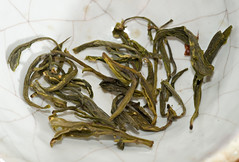

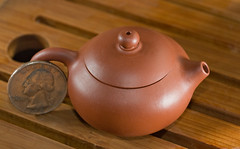
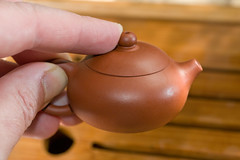
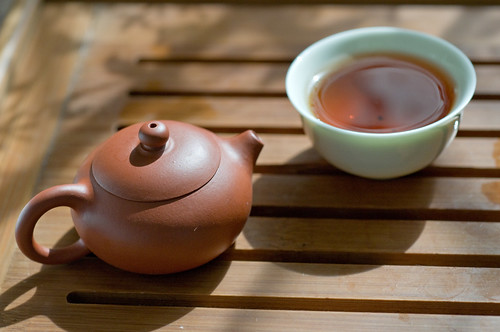
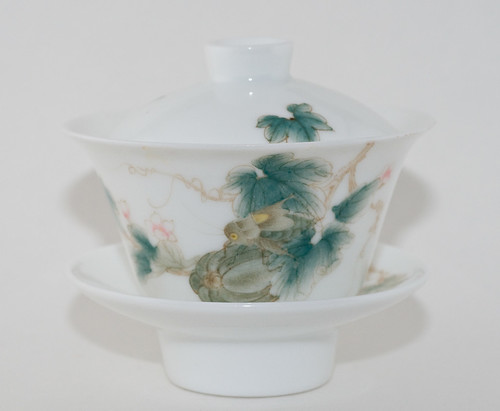


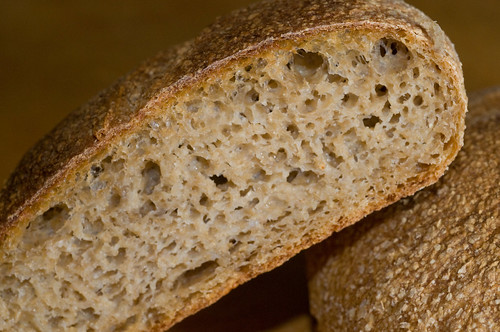
I need to try to care more about tea
in Coffee & Tea
Posted
Naah.
This is just the work collection
Tea at work ii by debunix, on Flickr
Haven't got a current photo of the home tea cabinet...